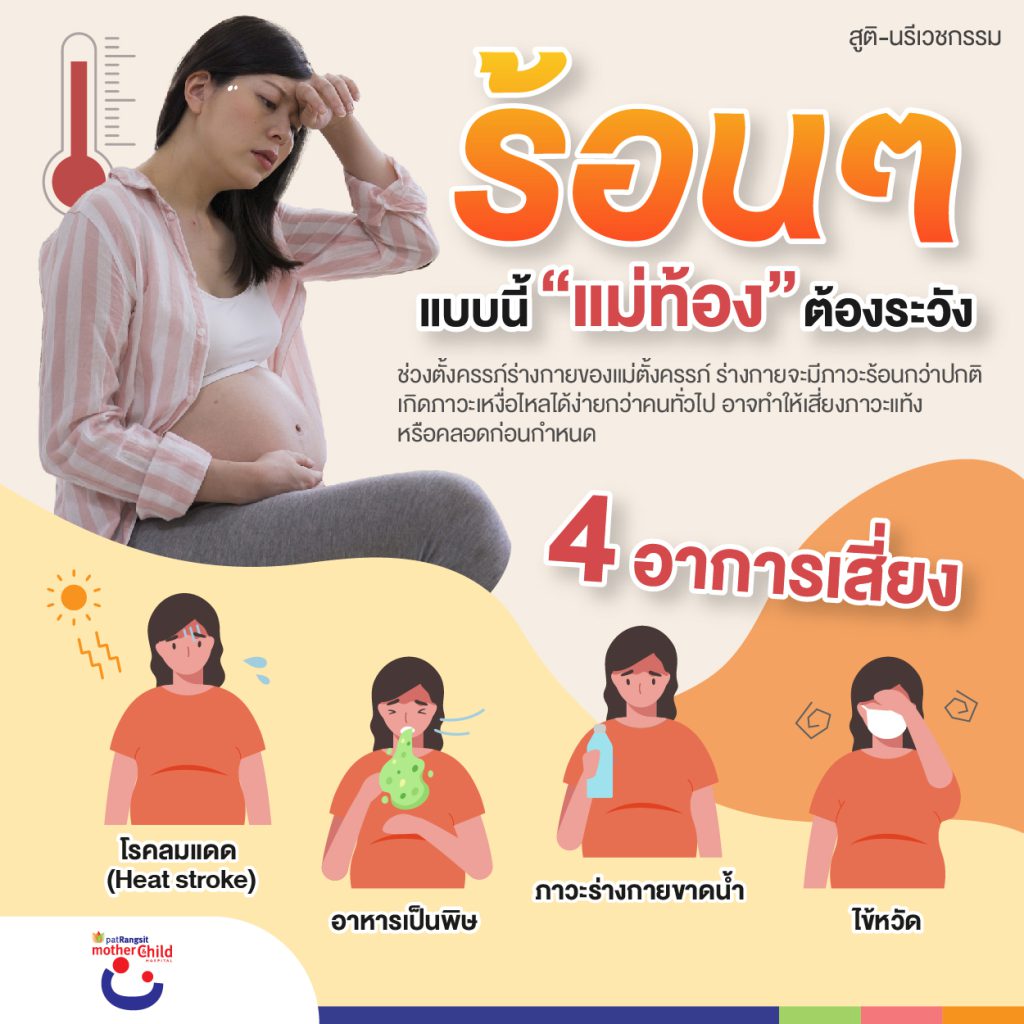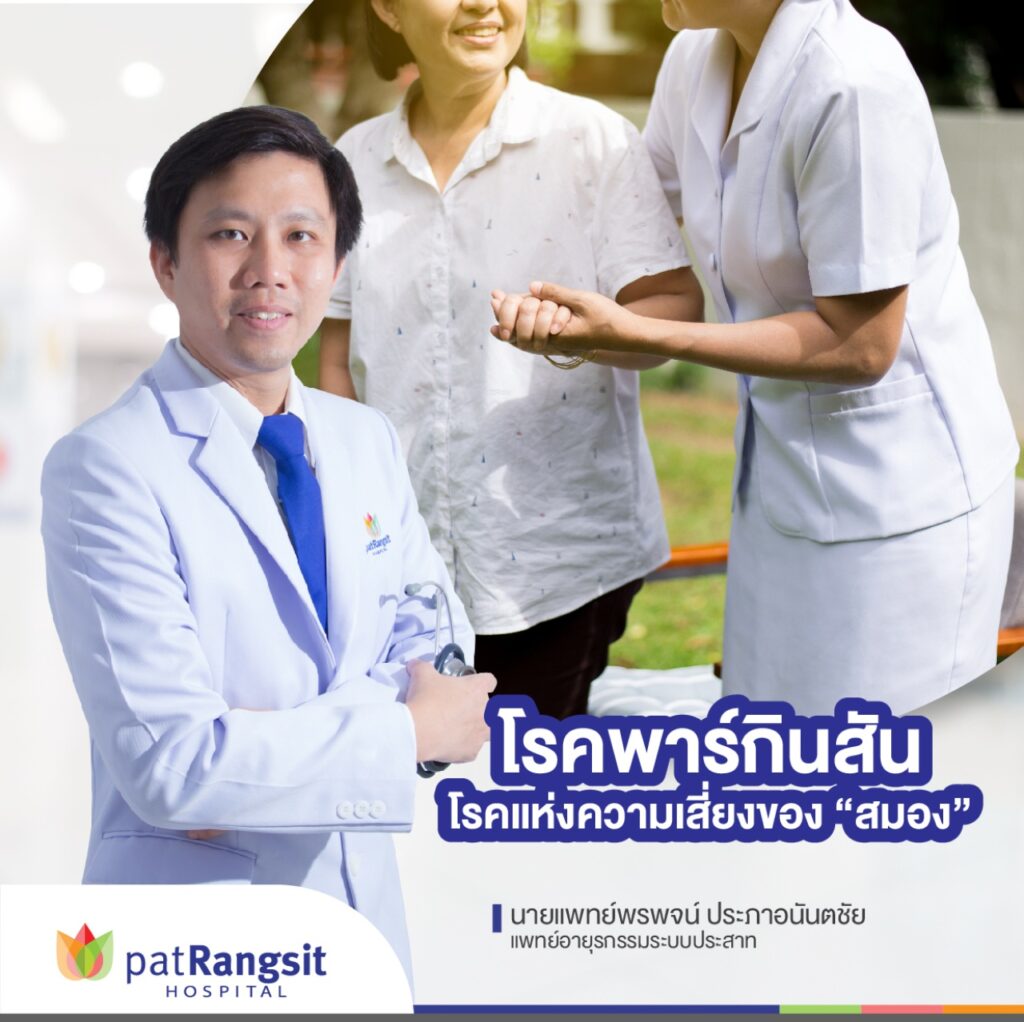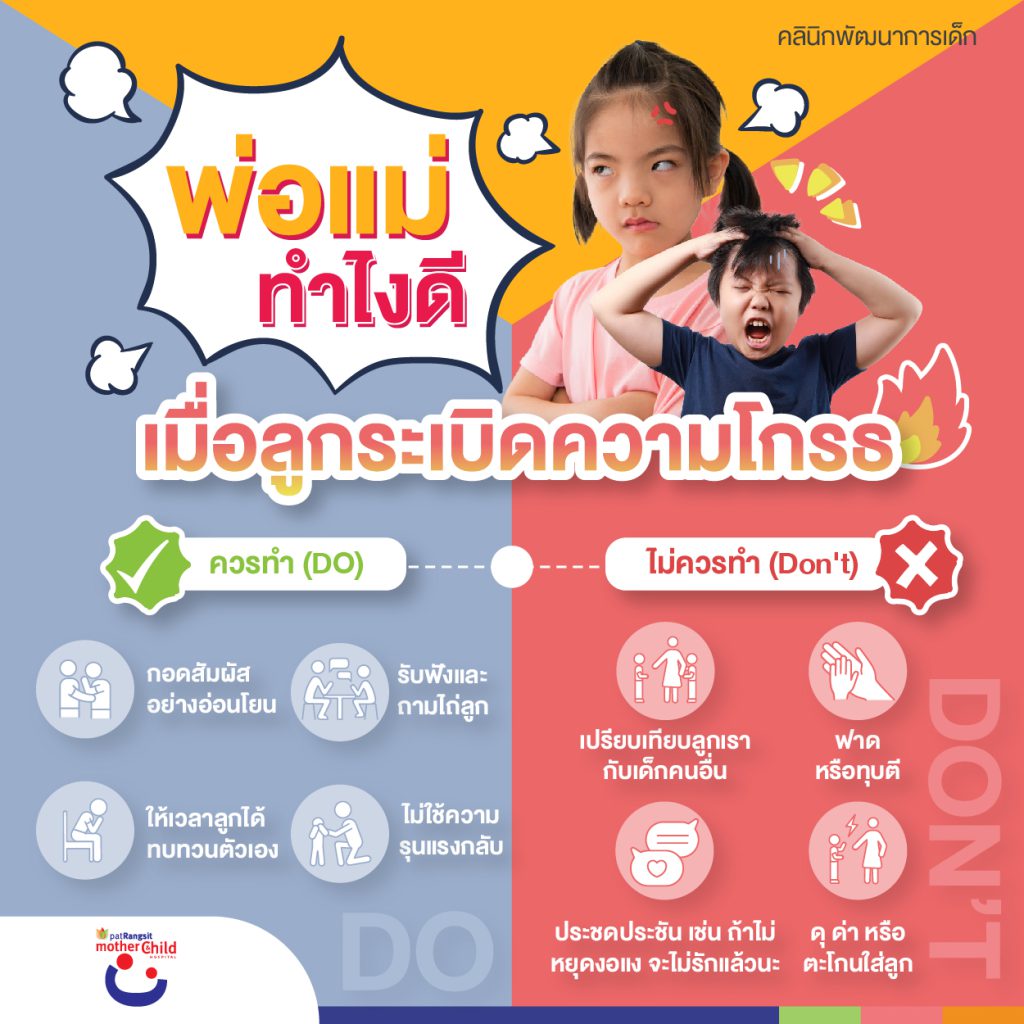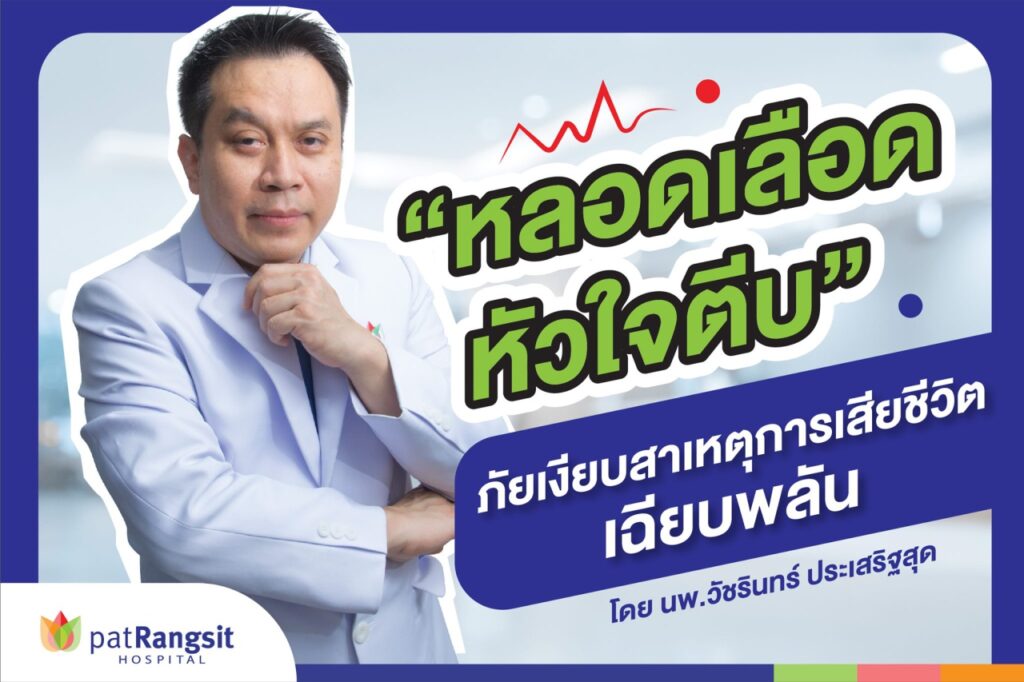
"Hot Summer Diseases" that pregnant women must be careful.
During pregnancy, the mother's body metabolizes food 20% better than normal people, causing the body to heat up and sweat easily. In the summer, there are more diseases that are likely to occur. Here are some recommendations for mothers to be concerned of in the summer.
Heat Stroke is caused by the body getting too much heat.
Symptoms: Fatigue, exhaustion, loss of appetite, headache, low blood pressure, etc. If not treated promptly, symptoms will get worse until convulsions, kidney failure, arrhythmia, shock, and thromboembolism, which can be life-threatening.
How to prevent + treat?
Dehydration
Dehydration occurs with heatstroke because when the body temperature rises, the body will sweat more than usual. It makes the blood more concentrated. This condition can stimulate the body to release the hormone oxytocin, which can result in premature labor.
Symptoms Dizziness, nausea, vomiting, fainting, hyperventilation or shortness of breath, muscle contractions or cramps, abnormal amount of fluid in the body such as sweat, low urine output, and elevated body temperature without other signs of illness.
How to prevent + treat?
Flu
If you have a cold during pregnancy, symptoms will get better a little later than normal people, because the immune system in the body is reduced. Most of the time, colds are not able to infect babies, but mothers should be careful. If mothers are infected with a severe cold, they may induce abortion in the first 3 months or preterm labor in the last trimester.
Symptoms: Coughing, sneezing, runny nose, not dangerous to baby. But when mother coughs hard, it may result in increased abdominal pressure, which may press on the uterus and cause the uterus to contract. If mothers have a fever higher than 38 degrees, they should see a doctor immediately. (Fever above 40 degrees can cause disabilities in babies.)
How to prevent + treat?
Cholera
It is caused by a bacterial infection in the intestines that may be contaminated with food and water.
Symptoms: diarrhea, vomiting, irritability, lethargy, sunken eyes, dry lips, extreme thirst, withered and dry skin, low urine output, and shock.
How to prevent + treat?
All the above symptoms are symptoms that expectant mothers may encounter. Therefore, keeping yourself healthy is essential to keep both mother and baby safe and healthy. If in case of abnormal symptoms, you should see a doctor immediately.
Source: Real Parenting magazine and website pobpad.com
Compiled by Dr. Suwannee Bamrerat

เรียบเรียงบทความโดย
พญ.สุวรรณี บำเรอราช

Cause
MIS-C is a syndrome with inflammation of various organs in the body. It is an emerging disease, which can occur after a child is infected with COVID-19. In the beginning, the child may have few symptoms or no symptoms of COVID-19 infection. After about 2-6 weeks (about 1 and a half months), the child will have a fever. It is believed to be caused by the body's immune response to COVID-19, then followed by the symptoms of inflammation of various organs.
Symptom
A child often has a high fever along with symptoms indicating inflammation of at least 2 other organs, the most common being the heart and gastrointestinal organs. Sometimes, a child may have symptoms that are related to several systems such as the skin system, respiratory system, nervous system, and urinary system. In young children, there may be symptoms like Kawasaki fever, including red eyes and rashes, but MIS-C is more severe to the circulatory system. It is severe because there is an aneurysm of the arteries that feed the heart; for instance, the contraction of the heart is abnormal. A child may likely get a seizure more than a child who has Kawasaki fever.
Treatment
The treatment has changed over the past two years. Research shows that the treatment is effective through Immunotherapy (IVIG) given intravenously. This treatment is the same as the treatment for Kawasaki fever. Immunosuppressants (steroids) and new drugs are used to treat localized inflammation in severe cases. Taking aspirin to reduce platelet aggregation can prevent thromboembolic complications in children with coronary artery aneurysms. Most of the treatment results are good but there is a mortality rate in severe cases. Long-term follow-up is still needed.
VDO:

"Forgetting" is a common occurrence among the elderly that should not be taken lightly, by Dr. Phanphat Prapapananchai, a specialist in geriatric medicine at PatRangsit Hospital.
Episodes of confusion and forgetfulness often occur, especially in older people. Sometimes we might dismiss it as a normal part of aging. However, as we age, these experiences can happen to anyone. For example, forgetting what we had for breakfast, not remembering where we placed an item, or not being able to find our glasses even though we thought they were on our head. These incidents can happen to anyone, but if they occur frequently and severely, impacting daily functioning or causing significant disruptions, it is not something that should be overlooked.
Many people mistakenly believe that episodes of confusion and forgetfulness are always signs of dementia. However, dementia is just one of the common conditions in the group of neurodegenerative diseases. Dementia refers to a progressive decline in cognitive abilities, behavior, and personality that is not present from birth and affects daily functioning. It becomes more prevalent with age, affecting around 5% of the population over the age of 65 and 20% of those over 80.
Other causes of cognitive decline include:
So, when should we become aware that it might be Alzheimer's disease? Let's consider the following:
If an elderly family member experiences any of these symptoms, it could be an indication of Alzheimer's disease or other health problems. It is recommended to consult a geriatrician or neurologist for a thorough examination and further treatment.
As for brain-boosting tips, here are some dietary recommendations:
These tips, in conjunction with seeking medical advice, can help promote cognitive well-being in older individuals.

บทความโดย
นพ.พรพจน์ ประภาอนันตชัย

Parkinson's disease is a condition that arises from brain cells in the part responsible for producing a chemical called dopamine, which plays a crucial role in controlling body movements, deteriorating to the point where it can no longer produce this substance. As a result, abnormal movements occur in the body. This disease is most commonly found in individuals aged 65-80 years, with men being more susceptible than women, approximately 1.5 times more likely. The progression of the disease is slow, and patients show more noticeable changes over time.
Causes of Parkinson's Disease:
Symptoms of Parkinson's Disease:
Treatment for Parkinson's Disease includes three main approaches:

บทความโดย
นพ.พรพจน์ ประภาอนันตชัย

Explosions of Anger Problems that Parents Must Address Urgently by Dr. Chonnipa Butwong, Specialist in Child and Adolescent Psychiatry at PatRangsit Hospital.
This article discusses the disruptive behavior of children, what causes irritable and easily angered children, how to take care of them, and why we should pay attention and understand them. Many disruptive behaviors often manifest as anger and frustration, which are primary symptoms of Oppositional Defiant Disorder and Conduct Disorder. However, children with other psychiatric disorders are also at risk of exhibiting disruptive, angry, and aggressive behaviors.
Research studies have found that the prevalence of disruptive behaviors ranges from 14% to 35%. Particularly in children with ADHD, the prevalence can increase to 14% to 62%, and in children with anxiety, it ranges from 9% to 45%.
However, anger is a natural part of emotions, although it involves increased physiological arousal. Anger often leads to thoughts of blame towards oneself or others, as it arises from frustration or provocation. Anger can last from minutes to hours and ranges from mild anger to extreme anger. Crying, stomping, pushing, hitting, and kicking are common expressions of anger in children aged 1-4 years, occurring 5-9 times a week on average, with durations of 5-10 minutes. However, the intensity and frequency of anger tend to decrease as children grow and age.
Uncontrolled outbursts of anger are problems that need to be addressed to help children develop emotional control skills and cope with anger and frustration effectively.
Methods that can be used to manage anger include:
Allowing yourself to articulate your feelings honestly can help turn your anger into understanding. Self-awareness will be coupled with self-control. Dealing with anger is not easy, and anger control is something that must be practiced gradually and continuously. It may not be possible to completely manage all feelings of anger immediately, but it is important to learn to control your anger so that it doesn't overwhelm you.


บทความโดย
พญ.ชนม์นิภา บุตรวงษ์

Warning Signs of Depression in Adolescents by Dr. Chonnipa Butwong, MD, Specialist in Child and Adolescent Psychiatry.
Depression is common in adolescents but often goes unnoticed. The incidence is particularly high in girls, with a prevalence of around 4-5% that increases rapidly during the onset and end of adolescence. Depression in adolescents is a major risk factor for suicide and can lead to educational and social difficulties. It is also associated with increased smoking rates, substance abuse, and obesity.
Several risk factors can contribute to depression in adolescents, such as a family history of depression, psychosocial stress, and increased sex hormones. Although there are similarities between depression in adolescents and depression in adults.
Long-term follow-up studies have shown that depressive symptoms in adolescence are initially mild. However, over time, there is an increased risk of more severe depressive symptoms. Therefore, it is crucial to pay attention to depression in adolescents, even if the symptoms are still mild.
Warning signs of teenage depression may include a persistently sad or irritable mood, loss of interest or enjoyment in activities for at least one week. Other accompanying symptoms may include:
In the case of depression in children, in addition to the mentioned symptoms, physical symptoms may also be present, such as frequent headaches or abdominal pain.
To help a child with depression, it is important to listen attentively, providing them with time to express themselves without prying questions. Allow them to talk about their feelings and any concerns they may have. Once they have finished explaining, acknowledge their efforts to solve past problems and offer suggestions or alternatives for them to consider and make decisions.
Treatment methods for depression include psychotherapy, counseling, family relationship adjustments, behavior modification, discussing problems with the school, and, in some cases, the use of antidepressant medication.
If parents suspect that their child may be experiencing depression, they should seek help from a pediatrician, school counselor, or mental health professional. These professionals can comprehensively assess the situation, make a diagnosis of depression, and identify appropriate treatment methods.

บทความโดย
พญ.ชนม์นิภา บุตรวงษ์

"COVID is over, but the symptoms persist: Introducing the condition of 'Long COVID'" by Dr. Siwaporn Charoenthat, Internal Medicine Specialist at PatRangsit Hospital
The condition known as "Long COVID" or alternatively referred to as "Post-COVID-19" is the presence of symptoms that persist after recovering from a COVID-19 infection. These long-term symptoms can continue to affect patients, even if the virus is no longer detected in their tests. Common symptoms include fatigue, easy exhaustion, shortness of breath, headaches, weakness in the limbs, body aches, cough, chest tightness, and even insomnia, depression, and anxiety. These symptoms can occur in 30-80% of individuals who have had a COVID-19 infection. The duration of these symptoms can be prolonged, and the exact cause is not yet clearly understood. It is believed to be related to the immune response of the body, which leads to inflammation in various tissues and organs.
Since the symptoms of Long COVID can manifest after recovering from COVID-19, if you experience abnormal symptoms or feel different than before after overcoming the disease, it is recommended to undergo a health check-up at the Rangsit Medical Hospital's Health Screening Center. We offer special health check-up packages after COVID-19 at a discounted price to identify and provide prompt treatment to restore you to a normal state of health.


"Coronary Artery Stenosis: The Silent Threat Leading to Sudden Death" by Dr. Watcharin Prasertsud, M.D., Internal Medicine Specialist in Balloon Angioplasty and Stenting of Coronary Arteries.
Coronary artery stenosis, commonly known as the "silent threat," is the leading cause of sudden death. It may or may not present warning signs, and even individuals with good physical health, such as athletes, journalists, or young people, can suddenly collapse.
Some individuals may experience warning signs but mistake them for other conditions, such as heartburn, chest discomfort, symptoms resembling acid reflux, shoulder pain, abdominal discomfort around the upper abdomen, jaw pain, or toothache.
The risk factors for coronary artery stenosis can be divided into two categories:
For individuals diagnosed with coronary artery stenosis, the first step is to reduce controllable risk factors and follow the doctor's recommendations, which may include medication. In cases where coronary angiography reveals stenosis in more than one vessel with more than 70% narrowing, medication alone may not be sufficient. Balloon angioplasty is performed to expand the narrowed coronary arteries, and in some cases with more than three stenoses, heart bypass surgery may be necessary.
Prevention of coronary artery stenosis involves reducing controllable risk factors, such as regular exercise (at least 30-40 minutes per day, five days a week). Those with risk factors for heart disease should undergo annual heart health check-ups.

บทความโดย
นพ.วัชรินทร์ ประเสริฐสุด

By accepting yourself, you can strengthen your self-esteem. This means acknowledging all aspects of yourself, both positive and negative.
Many people have low self-acceptance, which can stem from various reasons. According to psychological theories, developing self-esteem partly comes from the admiration of others for our efforts or actions. Some individuals with low self-acceptance may strive for grand achievements to validate themselves, believing it will make others or themselves see their self-worth. However, this may only provide short-term boosts to their self-esteem.
Lack of self-acceptance can make it difficult to cope with emotional distress. When we frequently have negative feelings about ourselves, it can disrupt the brain regions responsible for emotional regulation and stress management.
Positive social relationships, supportive communities, and social acceptance contribute to the development of self-respect. We should treat ourselves with respect, even when we make mistakes or fail to achieve goals. Offering self-forgiveness and self-encouragement helps us approach problems and manage them effectively. It is more beneficial to ourselves than blaming or criticizing ourselves or others, which can worsen emotional control and problem-solving abilities.
Developing self-acceptance skills allows us to empathize with ourselves. For example, writing a letter to ourselves about situations that have caused us pain, describing the circumstances without blaming anyone, including ourselves. Consider what we would say to a close friend facing similar difficulties. This way, when we encounter such situations again, we can respond with empathy towards ourselves.
There are three important components of self-empathy:
In the current situation, many unprecedented events have occurred that neither people nor we ourselves have encountered before. Numerous circumstances have caused loss, disappointment, or hopelessness. However, it is important to always remember to accept ourselves, to empathize with ourselves, and to forgive ourselves. Treat ourselves with compassion and understand that we are ordinary human beings who cannot control everything according to our desires. Develop mindfulness to better perceive various problems, so that everyone can manage their emotions and overcome obstacles, becoming individuals who have learned from the crises they have faced in life.

บทความโดย
พญ.ชนม์นิภา บุตรวงษ์

Get ready before stepping into the "Golden Age."
Menopause, also known as the "Golden Age," is a stage of life that brings physical and mental changes. It is caused by a decline in sex hormones, most of which are produced by the ovaries. As women age, ovarian function decreases, resulting in a gradual decrease in female hormone levels and various disorders in many body systems. Consulting with a specialist doctor can determine if you have entered menopause and how to receive appropriate treatment for maximum benefits.
What are the symptoms of entering the Golden Age?
Menopausal symptoms can be both physical and psychological and can last from a few days to several years, depending on the individual. Symptoms may begin before menopause, many years prior, or after menopause and gradually develop over time. These symptoms may come and go or persist continuously.
Physical symptoms commonly experienced during menopause include:
Psychological symptoms that may occur during menopause include:
How is menopause treated?
When entering menopause, it is important to seek advice from a specialist doctor regarding the following:

"Adolescence" is the period of change written by Dr. Chaninipha Butravong, a specialist child and adolescent psychiatrist at PatRangsit Mother & Child Hospital
Adolescence is a stage of life characterized by biological changes, such as hormones and brain development. There are complex changes in cognitive processes, as well as social changes, where teenagers begin to form close attachments to individuals outside their family and have an increased need for acceptance from society.
The adolescent brain undergoes significant changes compared to childhood. During this period, the brain branches out more, forming numerous connections and expanding the process of thinking and learning. However, this thinking process can be complex and overwhelming, leading to indecisiveness or poor decision-making.
As adolescents transition into late adolescence, the brain starts to reduce the number of nerve fibers, leaving only essential ones, which are then coated or insulated with myelin sheaths. This enhances the brain's connectivity, making it stronger and faster. As a result, adolescents develop a more systematic thought process and a more comprehensive perspective. The faster parents help adolescents learn how to manage their emotions, the better they will be able to transition into adulthood.
Therefore, when children grow into adolescence, parents must adapt to the changes that occur. Adolescents start expressing their opinions and emotions more clearly. Parents should gradually loosen their control and choose to engage in conversations that prohibit behaviors that may be harmful to the adolescent. It is important to start by listening to the adolescent's perspective because being a good listener can indirectly teach them to be good listeners, control their emotions, pay attention to conversations, prioritize important issues, show respect for others, and demonstrate acceptance of the child's worth. Although parents may not always agree with the adolescent in the end, adolescents will exhibit less oppositional behavior.
Adolescence is a stage in life where individuals seek their own identity and have various challenging experiences to assert their ability to take care of themselves as adults. However, this may also come with experimenting with drugs or engaging in sexual experiences. If parents can calmly listen to the adolescent and wait for them to express their thoughts, feelings, or desires, parents can offer encouragement or praise the adolescent's sincere efforts. Then, parents can gradually present different perspectives, not to make the adolescent think or do as they say, but to help them develop a more comprehensive understanding of the situation. Ultimately, adolescents must learn to make decisions for themselves and take responsibility for their choices.
Although external environments have an influence on the development of adolescent thinking, emotions, and socialization, research studies mostly support the notion that families have a significant influence on adolescent development.

บทความโดย
พญ.ชนม์นิภา บุตรวงษ์

"A mother's good intentions may sometimes trigger the symptoms of a child.”
Interview with the mother of a mental health patient, conducted by Doctor Chonnipa Butravong, Child and Adolescent Psychiatrist.
The beginning of seeking medical help
Mother: When my child was around 2 years old, I felt that he was different from other children. Due to my nursing background, I had some knowledge in this area, and reading books on mindfulness made me realize that my child was not typical.
I took my child to the hospital, and the doctor diagnosed him with Attention Deficit Hyperactivity Disorder (ADHD), which meant my child would not be able to stay still and sit in one place without moving. The doctor treated my child for about a year.
After we moved to a new house, during preschool, everything seemed normal. It was difficult to tell if there was anything abnormal. But when my child started grades 1 to 3, his academic performance deteriorated. He had difficulty understanding and comprehending what was being taught.
When my child reached grades 5 to 6, I took him to a psychiatrist due to his poor academic performance, suspecting a learning disorder (LD). The doctor prescribed medication, and at that time, my child's IQ test result was around 100.
In the early stages of high school, my child's academic performance improved because I helped and tutored him. The doctor suggested we try stopping the medication.
During the later years of high school, the same symptoms reappeared: poor academic performance and a lack of motivation. I took my child to the doctor again, and he underwent another IQ test when he entered university in their first year. The result was below 90.
My child's symptoms became severe during his university years. He experienced anxiety regarding exams and studying, which led to excessive crying and talking about the past. He would say that I didn't love them. I took them to a doctor who diagnosed him with bipolar disorder, but I disagreed and sought another opinion from a different hospital. The second doctor ruled out bipolar disorder and recommended behavioral therapy for my child.
What do you think of the phrase "go see a psychiatrist" = crazy?
It's simple. We have to think about our child. We want him to get better. We love him, and we don't care what others think. It has become more common in society nowadays, but initially, the father didn't understand. It might affect his mood sometimes, but he won't confront our child face-to-face. We, as parents, should discuss and handle it first, keeping our emotions in check.
The most important thing is love. We love him, understand him, listen to him, and make him trust us enough to talk and share their stories. We have to forgive him.
How do you cope with your child's emotions?
When my child is struggling and keeps crying, saying that I don't love him or that I abandoned him, I hug him and assure him that I am here. I let him speak first and listen to him.
When he struggles with understanding his studies, I study together with him, helping him with the content. I reassure him by saying, "We'll do this together." We need to instill confidence in him and believe that he can do it.
A mother's good intentions may sometimes trigger the child's symptoms.
We have good intentions for him because we care. Sometimes, we might unintentionally say or do something that triggers their symptoms. For example, asking, "Have you read the book yet?" We have to reflect on ourselves and see if we are the ones triggering them. We need to be the foundation for them and not forget about them. Sometimes, we might lose control and use harsh words or threats, but it's not beneficial. We have to remind ourselves to stay calm and speak gently to achieve better results. We need to be strong because we don't know the consequences of hurting them with our words.
How is your child doing now?
Currently, my child is studying online, and we have presentations to prepare. I am very excited, but my child remains calm. We have to practice and take it step by step. My child asks me frequently how he is doing if he has improved. I believe that if we provide him with more experiences, it will help. It all depends on perspective that we have to go through it together.
Do you have any messages for other parents?
For parents of children with ADHD or any other condition, we need to ask ourselves how we will support our children in the future and ensure that they can lead a happy life when we are not around. We may need to create an environment or help them discover their strengths and interests. We need to plan ahead.
Every child needs love, encouragement, and attention. We must not give up. We may have to sacrifice a little and do everything we can to make them feel normal.

บทความโดย
พญ.ชนม์นิภา บุตรวงษ์
เว็บไซต์นี้มีการใช้งานคุกกี้ เพื่อเพิ่มประสิทธิภาพและประสบการณ์ที่ดีในการใช้งานเว็บไซต์ของท่าน